The Aircraft Lubricant Market is estimated to be valued at USD 3.0 billion in 2025 and is projected to reach USD 5.0 billion by 2035, registering a compound annual growth rate (CAGR) of 5.4% over the forecast period.
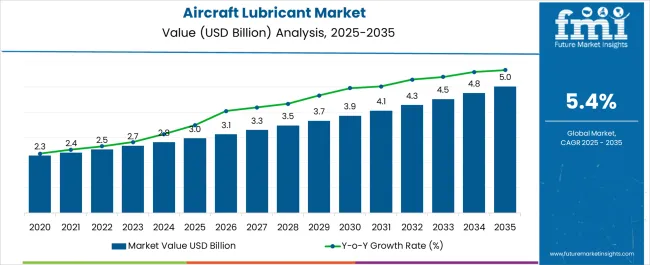
| Metric | Value |
|---|---|
| Aircraft Lubricant Market Estimated Value in (2025 E) | USD 3.0 billion |
| Aircraft Lubricant Market Forecast Value in (2035 F) | USD 5.0 billion |
| Forecast CAGR (2025 to 2035) | 5.4% |
The Aircraft Lubricant market is witnessing consistent expansion, supported by rising demand for high-performance lubricants that ensure efficiency, safety, and reliability in aviation operations. Increasing global passenger traffic, expansion of commercial airline fleets, and the growth of defense aviation are contributing to the rising consumption of specialized lubricants. Continuous advancements in aircraft engine design, including higher operating temperatures and pressures, are creating the need for advanced formulations that provide superior oxidation stability, wear protection, and thermal resistance.
Additionally, stringent safety regulations and maintenance requirements are encouraging airlines and maintenance providers to adopt premium-grade lubricants that extend equipment life and reduce downtime. The market is further being shaped by growing emphasis on sustainability, with bio-based and environmentally friendly lubricants gaining traction in the aviation industry.
Rising aircraft deliveries, fleet modernization programs, and increasing flight hours are all reinforcing demand across both commercial and defense aviation As airlines continue to focus on efficiency and operational excellence, the Aircraft Lubricant market is expected to remain on a robust growth trajectory, supported by technological innovation and increasing investments in aviation infrastructure.
The aircraft lubricant market is segmented by product type, end-use, grade, and geographic regions. By product type, aircraft lubricant market is divided into Gas Turbine Oil, Piston Oil, Grease, and Hydraulic Fluid. In terms of end-use, aircraft lubricant market is classified into Passenger and Defense. Based on grade, aircraft lubricant market is segmented into Multi Grade and Single Grade. Regionally, the aircraft lubricant industry is classified into North America, Latin America, Western Europe, Eastern Europe, Balkan & Baltic Countries, Russia & Belarus, Central Asia, East Asia, South Asia & Pacific, and the Middle East & Africa.
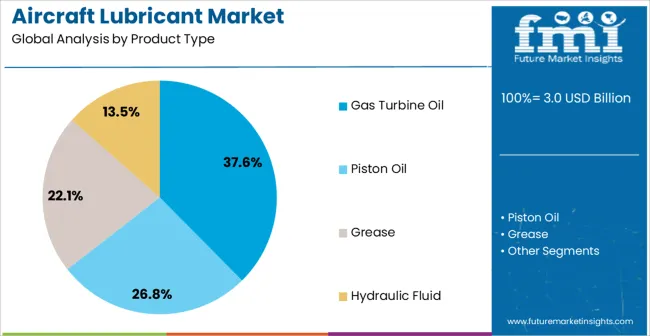
The gas turbine oil segment is projected to hold 37.6% of the Aircraft Lubricant market revenue in 2025, making it the leading product type. Its dominance is being driven by its critical role in modern aircraft engines, which operate under extreme thermal and mechanical conditions. Gas turbine oils are formulated to deliver exceptional thermal stability, oxidation resistance, and anti-wear protection, which are essential for the reliability of turbine engines.
The ability to maintain performance at high temperatures and extended operating cycles is a major factor supporting their widespread adoption. Airlines and defense operators are increasingly prioritizing engine efficiency and maintenance cost reduction, both of which are enhanced by high-quality turbine oils.
Continuous improvements in turbine technology are further driving demand for advanced lubricants capable of supporting longer service intervals and improved fuel efficiency As the aviation industry continues to expand globally, with growing fleets and rising flight activity, gas turbine oils are expected to retain their leadership position, supported by innovation in formulation and growing emphasis on operational reliability.
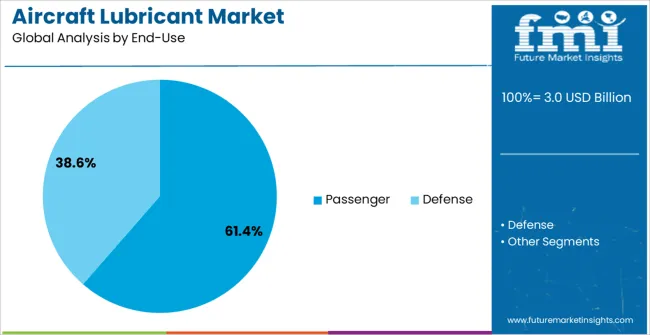
The passenger segment is anticipated to account for 61.4% of the Aircraft Lubricant market revenue in 2025, establishing it as the dominant end-use sector. Growth is being reinforced by the rising demand for air travel, particularly in emerging economies, which is leading to expanding commercial airline fleets and increased flight operations. Passenger aircraft place significant emphasis on safety, efficiency, and compliance, driving the adoption of premium lubricants to ensure engine performance and reliability.
Airlines are also under pressure to reduce operating costs and extend maintenance intervals, both of which are supported by advanced lubricant formulations. The rise in long-haul flights, coupled with higher passenger loads, further increases demand for lubricants that can sustain performance under extended operational conditions.
Additionally, regulatory requirements related to emissions and safety are pushing airlines to adopt innovative lubricants that meet stringent standards As global passenger traffic continues to grow and airlines modernize their fleets, the passenger end-use segment is expected to remain the largest contributor to market revenue, supported by ongoing industry expansion and technological advancements in lubricant chemistry.
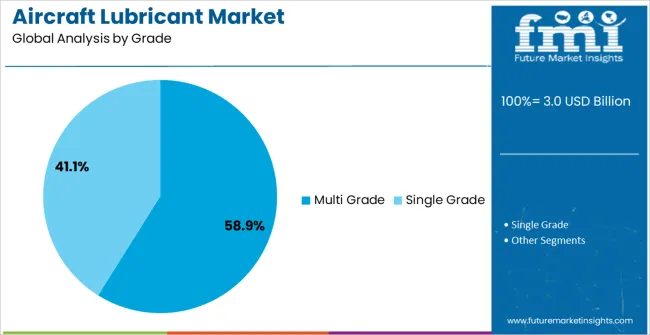
The multi grade segment is expected to hold 58.9% of the Aircraft Lubricant market revenue in 2025, making it the leading grade type. Its leadership is being driven by the flexibility and adaptability that multi grade lubricants provide in supporting performance across a wide range of temperatures and operating conditions. Unlike single grade oils, multi grade formulations ensure consistent viscosity and lubrication efficiency, improving reliability during start-up and extended flight operations.
Airlines and maintenance providers are increasingly choosing multi grade lubricants for their ability to reduce wear, improve energy efficiency, and extend engine life. The growing complexity of modern aircraft engines, which demand high-performance lubricants, further supports this segment’s prominence.
Moreover, the cost-effectiveness of multi grade lubricants, achieved through longer oil drain intervals and reduced maintenance needs, is appealing to both commercial and defense aviation operators As global aviation activity continues to rise and fleet modernization introduces more advanced engines, the demand for multi grade lubricants is expected to remain strong, ensuring its position as the leading grade in the Aircraft Lubricant market.
Lubrication requirements of an aircraft are generally very critical due to the three factors that dominate aircraft design – need for high reliability, minimizing component weight & volume and ability to withstand extreme environmental conditions.
Furthermore, aircraft engines must be lubricated to withstand extreme temperature and friction witnessed during high speed turbine revolution of aircraft engines, which is also capable of destroying aircraft engines. Early gas turbines successfully ran on mineral oil.
However, demand for new lubricants increased with the introduction of new gas turbine engines in mid-1900s. With the evolution of technology, turbo oils have shifted their focus from mineral to synthetic oils as unlike mineral oils, synthetic oils can maintain good viscosity and remain stable at high temperatures and are also less volatile.
Moreover, minimization of friction losses in an engine can be achieved through correct lubricating oil selection while taking various circumstances, such as ambient temperature, engine design, engine usage, time of year and climate, into consideration.
Gas turbine oil type lubricants are estimated to dominate the aircraft lubricant market during the forecast period owing to increasing engine efficiency due to efficient cooling provisions and corrosion prevention as well as the presence of cool and wash away debris, which serves as the diagnostic medium for engine monitoring features and lubricating moving parts.
Manufacturers are offering single or multi-grade mineral oils containing ash-free dispersing agents to meet international specifications.
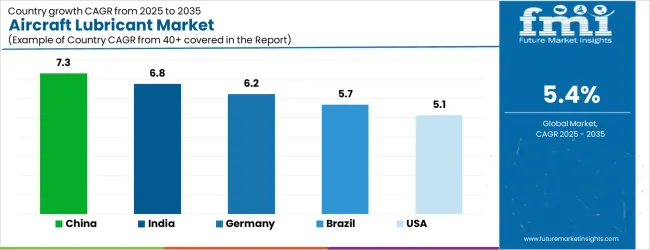
| Country | CAGR |
|---|---|
| China | 7.3% |
| India | 6.8% |
| Germany | 6.2% |
| Brazil | 5.7% |
| USA | 5.1% |
| UK | 4.6% |
| Japan | 4.1% |
The Aircraft Lubricant Market is expected to register a CAGR of 5.4% during the forecast period, exhibiting varied country level momentum. China leads with the highest CAGR of 7.3%, followed by India at 6.8%. Developed markets such as Germany, France, and the UK continue to expand steadily, while the USA is likely to grow at consistent rates. Japan posts the lowest CAGR at 4.1%, yet still underscores a broadly positive trajectory for the global Aircraft Lubricant Market. In 2024, Germany held a dominant revenue in the Western Europe market and is expected to grow with a CAGR of 6.2%. The USA Aircraft Lubricant Market is estimated to be valued at USD 1.1 billion in 2025 and is anticipated to reach a valuation of USD 1.1 billion by 2035. Sales are projected to rise at a CAGR of 0.0% over the forecast period between 2025 and 2035. While Japan and South Korea markets are estimated to be valued at USD 149.7 million and USD 100.1 million respectively in 2025.
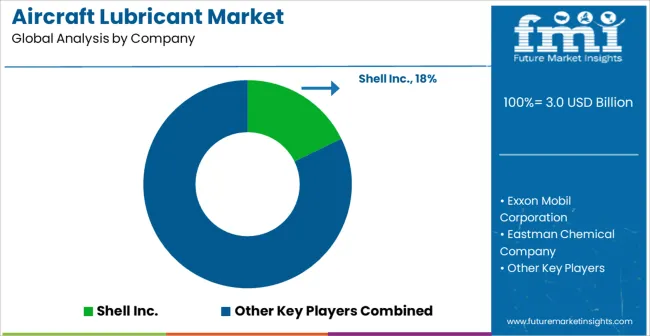
| Item | Value |
|---|---|
| Quantitative Units | USD 3.0 Billion |
| Product Type | Gas Turbine Oil, Piston Oil, Grease, and Hydraulic Fluid |
| End-Use | Passenger and Defense |
| Grade | Multi Grade and Single Grade |
| Regions Covered | North America, Europe, Asia-Pacific, Latin America, Middle East & Africa |
| Country Covered | United States, Canada, Germany, France, United Kingdom, China, Japan, India, Brazil, South Africa |
| Key Companies Profiled | Shell Inc., Exxon Mobil Corporation, Eastman Chemical Company, The Chemours Company, Kluber, Molykote., Morris Lubricants, Aviation Chemical Solutions, and Avioparts |
The global aircraft lubricant market is estimated to be valued at USD 3.0 billion in 2025.
The market size for the aircraft lubricant market is projected to reach USD 5.0 billion by 2035.
The aircraft lubricant market is expected to grow at a 5.4% CAGR between 2025 and 2035.
The key product types in aircraft lubricant market are gas turbine oil, piston oil, grease and hydraulic fluid.
In terms of end-use, passenger segment to command 61.4% share in the aircraft lubricant market in 2025.






Our Research Products

The "Full Research Suite" delivers actionable market intel, deep dives on markets or technologies, so clients act faster, cut risk, and unlock growth.

The Leaderboard benchmarks and ranks top vendors, classifying them as Established Leaders, Leading Challengers, or Disruptors & Challengers.

Locates where complements amplify value and substitutes erode it, forecasting net impact by horizon

We deliver granular, decision-grade intel: market sizing, 5-year forecasts, pricing, adoption, usage, revenue, and operational KPIs—plus competitor tracking, regulation, and value chains—across 60 countries broadly.

Spot the shifts before they hit your P&L. We track inflection points, adoption curves, pricing moves, and ecosystem plays to show where demand is heading, why it is changing, and what to do next across high-growth markets and disruptive tech

Real-time reads of user behavior. We track shifting priorities, perceptions of today’s and next-gen services, and provider experience, then pace how fast tech moves from trial to adoption, blending buyer, consumer, and channel inputs with social signals (#WhySwitch, #UX).

Partner with our analyst team to build a custom report designed around your business priorities. From analysing market trends to assessing competitors or crafting bespoke datasets, we tailor insights to your needs.
Supplier Intelligence
Discovery & Profiling
Capacity & Footprint
Performance & Risk
Compliance & Governance
Commercial Readiness
Who Supplies Whom
Scorecards & Shortlists
Playbooks & Docs
Category Intelligence
Definition & Scope
Demand & Use Cases
Cost Drivers
Market Structure
Supply Chain Map
Trade & Policy
Operating Norms
Deliverables
Buyer Intelligence
Account Basics
Spend & Scope
Procurement Model
Vendor Requirements
Terms & Policies
Entry Strategy
Pain Points & Triggers
Outputs
Pricing Analysis
Benchmarks
Trends
Should-Cost
Indexation
Landed Cost
Commercial Terms
Deliverables
Brand Analysis
Positioning & Value Prop
Share & Presence
Customer Evidence
Go-to-Market
Digital & Reputation
Compliance & Trust
KPIs & Gaps
Outputs
Full Research Suite comprises of:
Market outlook & trends analysis
Interviews & case studies
Strategic recommendations
Vendor profiles & capabilities analysis
5-year forecasts
8 regions and 60+ country-level data splits
Market segment data splits
12 months of continuous data updates
DELIVERED AS:
PDF EXCEL ONLINE
Aircraft Cabin Environment Sensor Market Forecast and Outlook 2025 to 2035
Aircraft Flight Control System Market Size and Share Forecast Outlook 2025 to 2035
Aircraft Electric Motor Market Forecast Outlook 2025 to 2035
Lubricant Market Size and Share Forecast Outlook 2025 to 2035
Aircraft Cooling Turbines Market Size and Share Forecast Outlook 2025 to 2035
Aircraft Smoke Detection and Fire Extinguishing System Market Size and Share Forecast Outlook 2025 to 2035
Aircraft Hose Fittings Market Size and Share Forecast Outlook 2025 to 2035
Aircraft Cabin Interior Market Size and Share Forecast Outlook 2025 to 2035
Aircraft Galley Systems Market Size and Share Forecast Outlook 2025 to 2035
Aircraft Interior Lighting Market Size and Share Forecast Outlook 2025 to 2035
Lubricants / Slip Agents Market Size and Share Forecast Outlook 2025 to 2035
Aircraft Battery Market Size and Share Forecast Outlook 2025 to 2035
Aircraft Floor Panels Market Size and Share Forecast Outlook 2025 to 2035
Aircraft Fuel Systems Market Size and Share Forecast Outlook 2025 to 2035
Aircraft Seat Market Size and Share Forecast Outlook 2025 to 2035
Aircraft Ground Support Equipment Market Size and Share Forecast Outlook 2025 to 2035
Aircraft Maintenance, Repair and Overhaul Market Size and Share Forecast Outlook 2025 to 2035
Aircraft Actuators Market Size and Share Forecast Outlook 2025 to 2035
Aircraft Elevator Market Size and Share Forecast Outlook 2025 to 2035
Aircraft Weapons Market Size and Share Forecast Outlook 2025 to 2035

Thank you!
You will receive an email from our Business Development Manager. Please be sure to check your SPAM/JUNK folder too.
Chat With
MaRIA